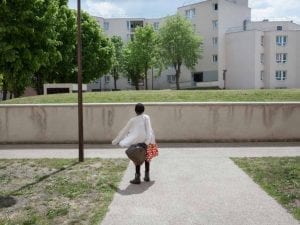Living and working in Düsseldorf, Germany, artist Anna Vogel (b. 1981) transforms found photography with painting techniques, such as varnish, acrylic, ink and pigment, to manipulate the reality of the natural landscape into a surrealist scene with exaggerated elements. Her work appears in a solo exhibition at Sprüth Magers, Berlin, from 8 July until 30 August. www.spruethmagers.com.
Your images are experimental, mixing graphics with photography; what do you aim to achieve with your work?
A few years ago I got to the point where pure, clean photography didn’t excite me any more. As a response, I began to work over images with varnish, ink, pencil and other visuals. What I find interesting is the way in which an abstract piece can still be perceived as a photograph. I think that the different layers in my artwork allow the audience to consider a range of interpretations. One of my intentions is that viewers will question how it was made.
You were taught by some hugely influential artists at Kunstakademie Düsseldorf, such as Thomas Ruff, Andreas Gursky and Christopher Williams. What did you learn from them?
I learnt different things from each of them. Thomas Ruff taught me to focus completely on one work and to pursue it until it is perfect, although I am not saying I have ever managed to achieve that. He also helped me to see that you have to be just as courageous to finish and then begin something new. I didn’t communicate very much with Christopher Williams, but Andreas Gursky particularly encouraged me to open up and to discuss my work. He also pushed me to try other artistic techniques, outside of photography.
In addition to your former lecturers and mentors, which other photographers have had an impact on your practice?
To be honest, I don’t identify with photographers so much any more. For the past few years, I have felt most inspired by painters. Vija Celmins’ Wüste, Meer und Sterne (2011) at the Museum Ludwig in Cologne was one of the most beautiful shows that I have ever seen. The perfection and reduction in her drawings astonished me and it has made a lasting impression. I have also been affected by Agnes Martin. I love the rhythm in her pieces and the consistency that is apparent in the way she works. Finally, I’d also have to add Gerhard Richter to the list. His small-format painted photographs and his black and white paintings have always made a singular impression on me.
You often incorporate the natural landscape in your images. What in particular attracts you to this type of visual scenery?
For me, the natural world is a place of desire, because it is an environment that I am rarely able to visit, like the rest of the population that live in cities. The detail that really attracts me in the organic world is the timelessness. Geological processes develop so slowly in comparison to human civilisation. In my art I like to reflect this contrast between the lasting, permanent elements of nature and the fast-paced way in which humans perceive things.
Are there any locations in the world that are of specific interest that you would like to travel to and photograph next?
Not really. I am not really interested in travelling to a place to then try and capture it through my camera; the magic is almost always lost. I also don’t feel free to alter the images of tourist sites because they are instantly recognisable. I prefer to use generic visuals, like a typical seaside scene, for example. So, I am not a hunter, I am a collector of material. When I use my photographs I have to wait until I don’t really remember the situation in which they were taken so I am freely able to transform them into something new.
Can you outline the ideas behind your Sunroad series?
Sunroad is not finished yet. The project is about the feeling of travelling and I wanted to reflect the shimmer in the air, objects rushing past in short flashes and the genre of the road trip. The road in the images passes through the Rocky Mountains for 53 miles. I have never been there – I found the images on the internet and manipulated them for the collection.
Photography is more accessible now than it ever has been before, and people are constantly uploading images to the internet. How do you think it will affect photography as an art form?
This is an interesting question because I am always searching the internet for material to use in my work. I want to eliminate the real individual in the many private snapshots which I stumble across. I describe this process as a remix, a bit like electronic music, in which a range of snippets become one piece of music. As an artist, I am pretty neutral about the daily influx of images online every day. A good photo will always continue to fascinate people, and really, it doesn’t matter how many pictures are shot on mobile phones.





